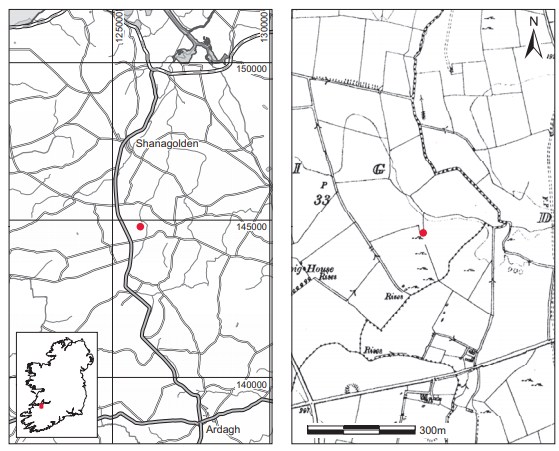County: Limerick Site name: MOIG, CO. LIMERICK
Sites and Monuments Record No.: SMR LI019-093001 Licence number: E1112
Author: ELLEN PRENDERGAST
Site type: Iron Age and early medieval graves, c. 300 BCc. AD 1200
Period/Dating: —
ITM: E 525860m, N 644841m
Latitude, Longitude (decimal degrees): 52.549850, -9.093178
Introduction
In February 1952 a long cist containing human bone was discovered during levelling of an enclosure at a farm near Shanagolden, Co. Limerick. The mechanical excavator had been levelling the banks surrounding a rectangular area known as ‘the Cilleens’ and in removing a stone inside the bank uncovered the grave at approximately 0.6m below ground level. The capstone of the cist was broken in the process but the rest of the grave was left intact. A neighbour of the landowner reported the find to the Garda Síochána at Shanagolden, who wrote to the NMI about the find. A one-day rescue excavation was undertaken by Ellen Prendergast.

The human remains from the site were examined by Professor Keenan. This report is based on Prendergast’s account of the excavation and on Keenan’s analysis of the human remains.
Location (Fig. 4.32)
The site was in the townland of Moig, north-west Co. Limerick, approximately 4km south of Shanagolden village.72 The enclosure is indicated by a deflection in the field fence on the map, and the site lay at an altitude of c. 120–150m above sea level. Although no other burials are known from the area, a number of enclosures are marked in the townland of Moig and may represent settlement during the period in which the cemetery was in use.
Description of site
An area 20m east/west by 24m north/south had been delimited by uneven earthen banks with an external ditch measuring approximately 3m deep and 3.6m wide at the eastern edge (Fig. 4.33). The cist was in the south-west corner of the enclosure. A patch of burnt soil containing charcoal was noticed outside the grave, at the western end. The relationship between this deposit and the cist was not established.
The grave was rectangular in outline with its long axis running east/west.73Internally it measured 1.1m long by 0.4m wide by 0.32m deep. The burial chamber was composed of six main slabs set on edge, with two slabs set end to end to form the northern and southern sides, a single slab closing each end. The maximum thickness of the side slabs was 0.11m. A number of smaller packing stones were placed at the junction of the end slabs. The cist was covered by a single capstone, which had been broken by the digger. It was paved with four main flat slabs, with a number of smaller stones placed in the interstices. The paving slabs appear to have been flat and regular in shape, and approximately 0.05m thick. These lay at a somewhat higher level than the bases of the side stones and were probably inserted after the latter had been placed in position. There is no evidence that the pit dug to receive the cist was located.
The grave contained the unburnt remains of at least three individuals (2010:82): an adult

male, a second adult (unsexed) and a young adult. No grave-goods were found, but in the cist fill were shells, fragments of poplar charcoal, fragments of animal bone and a small piece of rusted iron. None of the skeletons was articulated and some bones had been removed by visitors to the site before Prendergast’s investigation. Only the position of one of the skeletons could be ascertained. It appears to have lain in a supine position with the head to the west. In her report Prendergast speculates that the skeleton would originally have been extended, although this is difficult to reconcile as the internal length of the cist (according to the plan) was 1.1m, and it would therefore have been too short to fit the extended skeleton even of a sixteen-year-old.74
There is a possibility that the grave was intended for a juvenile, although the remains found in the grave appear to represent older individuals. A sample of the human remains was submitted for radiocarbon dating and yielded a date of 1250±40 BP, which calibrates to 674–874.75
Comment
It seems likely that this site was used as a burial ground in the early medieval period, and that more than one grave existed here. The use of a single capstone would appear to be quite unusual in an early medieval context, as would the short length of the cist, given that the interred were not juveniles.
HUMAN REMAINS
E.J. KEENAN
The fragmented remains in this collection (2010:82) are those of at least three human skeletons.
(A) Fragments of nearly all bones of a well-built male of about 30 years of age and approximately 5ft 8in. in stature. The condition of the skull did not allow of any measurements being made.
(B) Fragments of right and left tibiae, fibula and left os calcis of an adult human skeleton under 5ft 8in. in height.
(C) Two skull fragments and nine fragments of limb bones of a young person about sixteen years of age.
(D) Several fragments of non-human bone.
72. Parish of Kilmoylan, barony of Shanid. SMR LI019-093001-. IGR 125894 144795.
73. The east end of the cist appears to be tapered in the plan, but according to Prendergast this was due to the displacement of one of the southern side slabs during the discovery.
74. The average length of long cists containing extended inhumations in this corpus is approximately 2m.
75. GrA-24352.